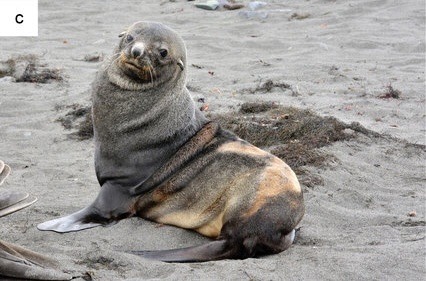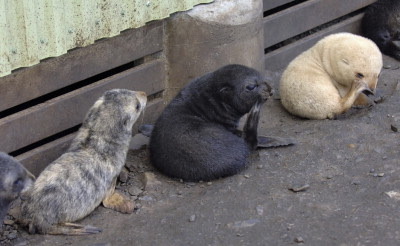Today's Seals Are: Robot Uprising
Today's Seals Are: Robot Uprising
More Posts from Fursealfan and Others
Begging you for some pinnipeds any pinnipeds please
Piebald Northern fur seal

Atypical colored Antarctic fur seal! With the orange, white, and grey they look calico.

Leucistic Antarctic fur seal

Interesting gang of Antarctic fur seal, one is leucistic and one almost looks brindle?

Leucistic southern elephant seal

Northern fur seal labeled as albino and partial albino (leucistic?) by some sources. NOAA says albino and they are experts.

Albino harbor seal

Albino ringed seal

Melanistic grey seal

welcome to my blubbery blog!!! 🦭🦦🐋🐬🫧
i’m currently a volunteer at an AZA accredited aquarium, i hope to study marine environmental science in the future and work in conservation and education! my primary interests are in northern fur seal biology and southern resident killer whale behaviour, but i love all marine mammals!
i support accredited* zoos and aquariums! i do however hope that we can move away from them in the future. i think that conversations about the ethics of captivity are important and should always be centered around the wellbeing of the captive animals. i encourage caution and use of critical thinking around both anti and pro captivity arguments. i’m always happy to answer any questions about the practices of AZA accredited zoos and aquariums!
*there are some accredited zoos and aquariums (such as seaworld) that i am heavily critical of, but it’s unfortunately a complicated issue that isn’t realistic to have black and white opinions on.
marine mammal rescue, conservation, and research organisations:
alaska sealife is center
vancouver aquarium marine mammal rescue society
center for whale research
SR3
marine mammal care center

lets be muddy with mama

"Eavesdropping on whale songs over the last six years is providing new information vital to answering questions about these giants of the ocean.
The number of whale songs detected is associated with shifting food sources, according to the California scientists—and the number of days humpbacks have been singing has nearly doubled.
When monitoring baleen whale songs in the Pacific Ocean, researchers found year-to-year variations correlated with changes in the availability of the species they forage on.
In vast oceans, monitoring populations of large marine animals can be a “major challenge” for ecologists, explained Dr. John Ryan, a biological oceanographer at the Monterey Bay Aquarium Research Institute in California (MBARI).
Their team deployed underwater microphones called hydrophones to study and track baleen whales, which communicate over long distances through sound.
“Surprisingly, the acoustic behavior of baleen whales provides insights about which species can better adapt to changing ocean conditions,” said Dr. Ryan, a lead author of the study.
They also monitored songs from blue, fin, and humpback whales off the West Coast of the U.S. to see what the song data could reveal about the health of their ecosystem.
The findings, published in the journal PLOS One, showed “large” year-to-year variations in whale song detection.
“The amount of humpback whale song continually increased, with their songs being detected on 34% of days at the beginning of the study and rising to 76% of days after six years,” said Dr. Ryan.
“These increases consistently tracked improved foraging conditions for humpback whales across all study years—large increases in krill abundance, followed by large increases in anchovy abundance.
“In contrast, blue and fin whale song rose primarily during the years of increasing krill abundance.
“This distinction of humpback whales is consistent with their ability to switch between dominant prey. An analysis of skin biopsy samples confirmed that changes had occurred in the whales’ diets.”
He explained that other factors, including the local abundance of whales, may have contributed to patterns in song detections observed in some years, but changes in foraging conditions were the most consistent factor.
“Overall, the study indicates that seasonal and annual changes in the amount of baleen whale song detected may mirror shifts in the local food web.”
WHALES ON THE COMEBACK TRAIL: • Gray Whale, Extinct for Centuries in Atlantic, Is Spotted in Cape Cod • Sighting of Many Blue Whales Around Seychelles is First in Decades – ‘Phenomenal’ • Majestic Sei Whales Reappear in Argentine Waters After Nearly a Century
“The results suggest that an understanding of the relationship between whale song detection and food availability may help researchers to interpret future hydrophone data, both for scientific research and whale management efforts”, which could better protect endangered species."
-via Good News Network, March 1, 2025
i love this "with mama" meme. mm yes give me more baby animals with mmama.
please stop calling the california sea lions that are acting abnormally “demonic”. they are experiencing domoic acid toxicosis. domoic acid (DA) is a neurotoxin that is made by an algae called pseudo-nitzschia australis. fish eat the algae and the sea lions eat the fish. this buildup of DA in their system is what causes the behaviours we’re seeing. symptoms of DA toxicosis include: lethargy, disorientation, unpredictable behaviour, seizures, brain damage, and eventually death.
as far as we know, there have only been two unprovoked sea lion attacks on beaches. the vast majority of sea lions with DA toxicosis are not aggressive unless provoked. they are disoriented and they are acting out of fear.
DA is naturally occurring, but the algal blooms of pseudo-nitzschia australis have been increasing due to rising temperatures from climate change and water pollution. we are doing this to them.
affected sea lions seem to have pretty much a 50% chance of survival with treatment. they need IV fluids to flush out the toxin and some will need seizure medication as well. the marine mammal care center is completely overwhelmed with the amount of sick sea lions they are taking in and they need funding to keep up. you can donate to them here.
always stay at least 45 meters / 50 yards away from marine mammals! it protects both them and us!
Animal welfare advocacy should be about the animals, not an agenda

J62!!!
source: center for whale research
potato chip’s old man groan…
via
-
 faerypaw reblogged this · 2 weeks ago
faerypaw reblogged this · 2 weeks ago -
 neodotexe liked this · 2 weeks ago
neodotexe liked this · 2 weeks ago -
 nyamumujica reblogged this · 3 weeks ago
nyamumujica reblogged this · 3 weeks ago -
 nyamumujica liked this · 3 weeks ago
nyamumujica liked this · 3 weeks ago -
 gardentears reblogged this · 3 weeks ago
gardentears reblogged this · 3 weeks ago -
 gardentears liked this · 3 weeks ago
gardentears liked this · 3 weeks ago -
 kirbymongerr reblogged this · 3 weeks ago
kirbymongerr reblogged this · 3 weeks ago -
 kirbymongerr liked this · 3 weeks ago
kirbymongerr liked this · 3 weeks ago -
 eclectricityfence liked this · 3 weeks ago
eclectricityfence liked this · 3 weeks ago -
 dozeysheep liked this · 3 weeks ago
dozeysheep liked this · 3 weeks ago -
 slug-deluxe reblogged this · 4 weeks ago
slug-deluxe reblogged this · 4 weeks ago -
 slug-deluxe liked this · 4 weeks ago
slug-deluxe liked this · 4 weeks ago -
 pomogando liked this · 4 weeks ago
pomogando liked this · 4 weeks ago -
 futuristicchaospeach liked this · 1 month ago
futuristicchaospeach liked this · 1 month ago -
 foof-00 liked this · 1 month ago
foof-00 liked this · 1 month ago -
 chippiethegoober liked this · 1 month ago
chippiethegoober liked this · 1 month ago -
 nayters liked this · 1 month ago
nayters liked this · 1 month ago -
 dancingislike-heaven liked this · 1 month ago
dancingislike-heaven liked this · 1 month ago -
 fursealfan reblogged this · 1 month ago
fursealfan reblogged this · 1 month ago -
 fursealfan liked this · 1 month ago
fursealfan liked this · 1 month ago -
 rapprox-exe liked this · 1 month ago
rapprox-exe liked this · 1 month ago -
 crazyfandomguy23 liked this · 1 month ago
crazyfandomguy23 liked this · 1 month ago -
 competition-sky liked this · 1 month ago
competition-sky liked this · 1 month ago -
 hem0mancy liked this · 1 month ago
hem0mancy liked this · 1 month ago -
 glaucidian reblogged this · 1 month ago
glaucidian reblogged this · 1 month ago -
 glaucidian liked this · 1 month ago
glaucidian liked this · 1 month ago -
 onesacrificiallamb liked this · 1 month ago
onesacrificiallamb liked this · 1 month ago -
 capn-rattlebones reblogged this · 1 month ago
capn-rattlebones reblogged this · 1 month ago -
 capn-rattlebones liked this · 1 month ago
capn-rattlebones liked this · 1 month ago -
 auth-z-bypass reblogged this · 1 month ago
auth-z-bypass reblogged this · 1 month ago -
 real-live-human reblogged this · 1 month ago
real-live-human reblogged this · 1 month ago -
 nevah-nevah liked this · 1 month ago
nevah-nevah liked this · 1 month ago -
 fermenteddetails liked this · 1 month ago
fermenteddetails liked this · 1 month ago -
 jillyjillyhillbilly liked this · 1 month ago
jillyjillyhillbilly liked this · 1 month ago -
 gorillawithautism reblogged this · 1 month ago
gorillawithautism reblogged this · 1 month ago -
 cookie-cat-kestrel liked this · 1 month ago
cookie-cat-kestrel liked this · 1 month ago -
 want-some-pasta reblogged this · 1 month ago
want-some-pasta reblogged this · 1 month ago -
 dogplanet liked this · 1 month ago
dogplanet liked this · 1 month ago -
 wisteriapath reblogged this · 1 month ago
wisteriapath reblogged this · 1 month ago -
 enderanomaly liked this · 1 month ago
enderanomaly liked this · 1 month ago -
 tmpouch47 liked this · 1 month ago
tmpouch47 liked this · 1 month ago -
 chinesecentury reblogged this · 1 month ago
chinesecentury reblogged this · 1 month ago -
 penixels liked this · 1 month ago
penixels liked this · 1 month ago -
 hballegro liked this · 1 month ago
hballegro liked this · 1 month ago -
 themsthebreaksunu liked this · 1 month ago
themsthebreaksunu liked this · 1 month ago -
 romysoph2 reblogged this · 1 month ago
romysoph2 reblogged this · 1 month ago -
 romysoph2 liked this · 1 month ago
romysoph2 liked this · 1 month ago -
 halifacs liked this · 1 month ago
halifacs liked this · 1 month ago -
 kriscord liked this · 1 month ago
kriscord liked this · 1 month ago

